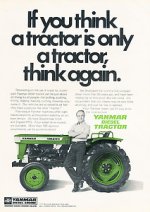jerrybob
Super Member
Kinda sounds like this???? It's normal! Great engine and tractor!! Congrats!
3 CILINDER YANMAR DIESEL ON JOHN DEERE TRACTOR - YouTube
3 CILINDER YANMAR DIESEL ON JOHN DEERE TRACTOR - YouTube
I wish my YM240 sounded all pretty like that. This YouTube vid is what they really sound like. (After this owner spends 40 seconds -unnecessary- playing with the thermostart).
I wish my YM240 sounded all pretty like that. This YouTube vid is what they really sound like. (After this owner spends 40 seconds -unnecessary- playing with the thermostart).
CLANK CLANK CLANK RAP RAP RAP CLANK CLANK CLANK ... The sound is like a bunch of clowns hammering on a manhole cover with sledges. Everyone's first impression is that a rod is about to come through the block. No. They just sound like that.
Yea.......mine sounds like a kitten purring.......while driving pilings!:laughing:
Ha ha, i stood next to mine today while it was idling at about 1050 RPM, just listening. Its mesmorising after a while
